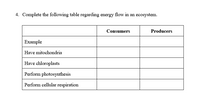
Human Anatomy & Physiology (11th Edition)
11th Edition
ISBN: 9780134580999
Author: Elaine N. Marieb, Katja N. Hoehn
Publisher: PEARSON
expand_more
expand_more
format_list_bulleted
Question
thumb_up100%

Transcribed Image Text:4. Complete the following table regarding energy flow in an ecosystem.
Consumers
Producers
Example
Have mitochondria
Have chloroplasts
Perform photosynthesis
Perform cellular respiration
Expert Solution
arrow_forward
Step 1
Energy flow in ecosystem takes from a lower trophic level to higher trophic level.
Producers in ecosystem includes all plants and algae.
Consumers includes all the animals, birds, insects etc.
Trending nowThis is a popular solution!
Step by stepSolved in 2 steps

Knowledge Booster
Learn more about
Need a deep-dive on the concept behind this application? Look no further. Learn more about this topic, biology and related others by exploring similar questions and additional content below.Similar questions
- Create a model which accurately, in detail, depicts the potential pathways of carbon and energy in an ecosystem with the following organisms: grass, mice, snakes, and hawks (don’t forget your decomposers as well).Make sure to incorporate multiple pathways and clearly illustrate how carbon and energy flow in this ecosystem.arrow_forwardState the second law of thermodynamics and apply it to the energy transfer from a trophic level to the next higher trophic level in a food chain.arrow_forwardIm stuck on this question, please help.arrow_forward
- A Lab Data NaHC 1 budy volume U₂ (ML) Tube 1 Green Light 3.3 3.5 3.7 3.8 4 2.1 H June cre Rate of volume change(- hr Time(min) How to Calculate Rate of Volume Change Green light Rate of photosynthesis mL Rate of photosynthesis ( -) = Rate of volume change light mL hr hr Time (min) 0 5 10 15 20 Rate of volume change (mL/hr) Tube 2 Green Control 3.3 3 2.6 2.3 1.9 -4.2 Tube 1 Blue Light 2.9 4.2 5.5 6.7 8 15.3 шп hr × 60(¹ Tube 2 Blue Control 2.9 2.6 2.2 1.9 1.5 -4.2 Blue light mL hr Rate of volume change covered liji - Xarrow_forwardExplain how energy flow supports the second law of thermodynamics in an ecosystem.arrow_forwardplease draw! Create a model which accurately, in detail, depicts the potential pathways of carbon (biomass) and energy in an ecosystem with at least five trophic levels (don’t forget your decomposers, they can count as one trophic level). Make sure to incorporate the multiple pathways that biomass and energy could take at each trophic level. Lastly, clearly illustrate how carbon and energy flow in this ecosystem. Be sure to include adequate levels of detail for all pathways and differentiate the flow of carbon and energy in your model.arrow_forward
- Thinking Analytically Is phytoplankton productivity highest at the ocean surface? What advantage would optimum productivity at a depth below the surface provide to phytoplankton?arrow_forwardMarine biology question 6) Just before the beginning of the fishing season you capture, tag, and release 4500 adult cod (Gadus morhua) from the Barents Sea. At the end of the season you learn from the United Kingdom Trawler Fleet working these waters that a total 195,500 fish were taken in the season, of which 1,950 fish were found bearing your tag. From these data calculate the “fishing ratio”, also known as the rate of exploitation, of this fishery. What was the size of the cod population actually available to this fishery at the beginning of the season?arrow_forwardCycles of Matter and Energy Transfer in Ecosystems:Question 1 Which statement is true about photosynthesis? Select one: One of the inputs of photosynthesis is oxygen. O During photosynthesis, energy from the sun is stored in the chemical bonds of a glucose molecule. Photosynthesis happens in the mitochondria. Photosynthesis releases energy to the environment.arrow_forward
arrow_back_ios
arrow_forward_ios
Recommended textbooks for you
 Human Anatomy & Physiology (11th Edition)BiologyISBN:9780134580999Author:Elaine N. Marieb, Katja N. HoehnPublisher:PEARSON
Human Anatomy & Physiology (11th Edition)BiologyISBN:9780134580999Author:Elaine N. Marieb, Katja N. HoehnPublisher:PEARSON Biology 2eBiologyISBN:9781947172517Author:Matthew Douglas, Jung Choi, Mary Ann ClarkPublisher:OpenStax
Biology 2eBiologyISBN:9781947172517Author:Matthew Douglas, Jung Choi, Mary Ann ClarkPublisher:OpenStax Anatomy & PhysiologyBiologyISBN:9781259398629Author:McKinley, Michael P., O'loughlin, Valerie Dean, Bidle, Theresa StouterPublisher:Mcgraw Hill Education,
Anatomy & PhysiologyBiologyISBN:9781259398629Author:McKinley, Michael P., O'loughlin, Valerie Dean, Bidle, Theresa StouterPublisher:Mcgraw Hill Education, Molecular Biology of the Cell (Sixth Edition)BiologyISBN:9780815344322Author:Bruce Alberts, Alexander D. Johnson, Julian Lewis, David Morgan, Martin Raff, Keith Roberts, Peter WalterPublisher:W. W. Norton & Company
Molecular Biology of the Cell (Sixth Edition)BiologyISBN:9780815344322Author:Bruce Alberts, Alexander D. Johnson, Julian Lewis, David Morgan, Martin Raff, Keith Roberts, Peter WalterPublisher:W. W. Norton & Company Laboratory Manual For Human Anatomy & PhysiologyBiologyISBN:9781260159363Author:Martin, Terry R., Prentice-craver, CynthiaPublisher:McGraw-Hill Publishing Co.
Laboratory Manual For Human Anatomy & PhysiologyBiologyISBN:9781260159363Author:Martin, Terry R., Prentice-craver, CynthiaPublisher:McGraw-Hill Publishing Co. Inquiry Into Life (16th Edition)BiologyISBN:9781260231700Author:Sylvia S. Mader, Michael WindelspechtPublisher:McGraw Hill Education
Inquiry Into Life (16th Edition)BiologyISBN:9781260231700Author:Sylvia S. Mader, Michael WindelspechtPublisher:McGraw Hill Education

Human Anatomy & Physiology (11th Edition)
Biology
ISBN:9780134580999
Author:Elaine N. Marieb, Katja N. Hoehn
Publisher:PEARSON

Biology 2e
Biology
ISBN:9781947172517
Author:Matthew Douglas, Jung Choi, Mary Ann Clark
Publisher:OpenStax

Anatomy & Physiology
Biology
ISBN:9781259398629
Author:McKinley, Michael P., O'loughlin, Valerie Dean, Bidle, Theresa Stouter
Publisher:Mcgraw Hill Education,

Molecular Biology of the Cell (Sixth Edition)
Biology
ISBN:9780815344322
Author:Bruce Alberts, Alexander D. Johnson, Julian Lewis, David Morgan, Martin Raff, Keith Roberts, Peter Walter
Publisher:W. W. Norton & Company

Laboratory Manual For Human Anatomy & Physiology
Biology
ISBN:9781260159363
Author:Martin, Terry R., Prentice-craver, Cynthia
Publisher:McGraw-Hill Publishing Co.

Inquiry Into Life (16th Edition)
Biology
ISBN:9781260231700
Author:Sylvia S. Mader, Michael Windelspecht
Publisher:McGraw Hill Education